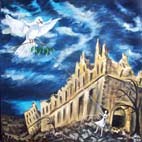The Battle of Cassino was, in effect, four battles. The third battle, involving the New Zealanders, began on the 15th of March when the town of Cassino was bombed. Here is a summary of the battles, with New Zealand involvement highlighted in bold. (The Gustav Line stretched from coast to coast, and passed through Cassino. Montecassino was the peak that commanded views and control of the Liri Valley, through which passed the road to Rome.
The four battles of Cassino, 1944:
January 17 American Forces commence first attack on Cassino.
January 22 American Forces land at Anzio in an attempt to go beyond the Gustav Line
February 5 American Divisions are replaced by 2nd New Zealand Division (including 4th Indian Division) at Cassino.
Feb 15-17 2nd Battle of Cassino New Zealand (Maori) Battalion at railway station, Indian Division at Montecassino.
March 15-16 3rd Battle of Montecassino (New Zealand).
May 11-18 4th Battle of Montecassino (Polish Division of Allied Forces). The German troops withdraw to avoid being cut off by the French and British forces now in the Liri Valley.
In the third battle the aim was to take Rocca Janula, or Castle Hill, a defensive position above the town on Monte Cassino. The previous attacks involving New Zealanders were in the town itself.
15 March NZers (D company of 25th Battalion) came via Parallel Rd and Caruso Rd. Because the town had not been cleared of Germans the NZers had to change plans, and come up via a ravine north of Castle Hill.
In its attack up the cliff face, McNiece and Stockwell went ahead and surprised the German sentries, throwing grenades into the pill box to take out the Spandau and bring about the surrender of 25 paratroopers. Two were killed. Both NZers were awarded the Military medal for this attack. From this attack, the Germans came to life. Involved then were also the Essex regiment, the Rajputana Rifles and the Ghurka rifles.
***
The German history books talk about three battles of Cassino. Most other nations refer to four battles. I maintain that there were in fact five battles; I include one that lasted until 1947 and is scarcely touched on in the history books.
The fifth battle at Cassino: Malaria.
When the front moved on at the beginning of June, 1944, and the civilians who had survived the battles and those who had been evacuated returned to their homes, they found a new and deadly enemy, malaria, had occupied the entire area of their town.
Conditions resulting from war damage suited the spreading epidemic: the earth left uncultivated and abandoned, the thousands of craters filled with water, the lack of hygiene and the roaming domestic animals, conditions which attracted the harmful mosquito “anophele”.
This became known as “the other battle of Cassino”, fought by the common people who had been left with nothing and who thought that now the fury of war was over they could concentrate on rebuilding their homes.
In the period between 1943 and 1946 45,000 people would contract malaria. This battle was fought mostly thanks to the contribution of Doctor Alberto Coluzzi, who with the massive use of DDT succeeded in controlling the disease in 1947.
(Malaria text from a panel for the Cassino War Memorial Museo, translated by blog author).
Subscribe to:
Post Comments (Atom)












No comments:
Post a Comment